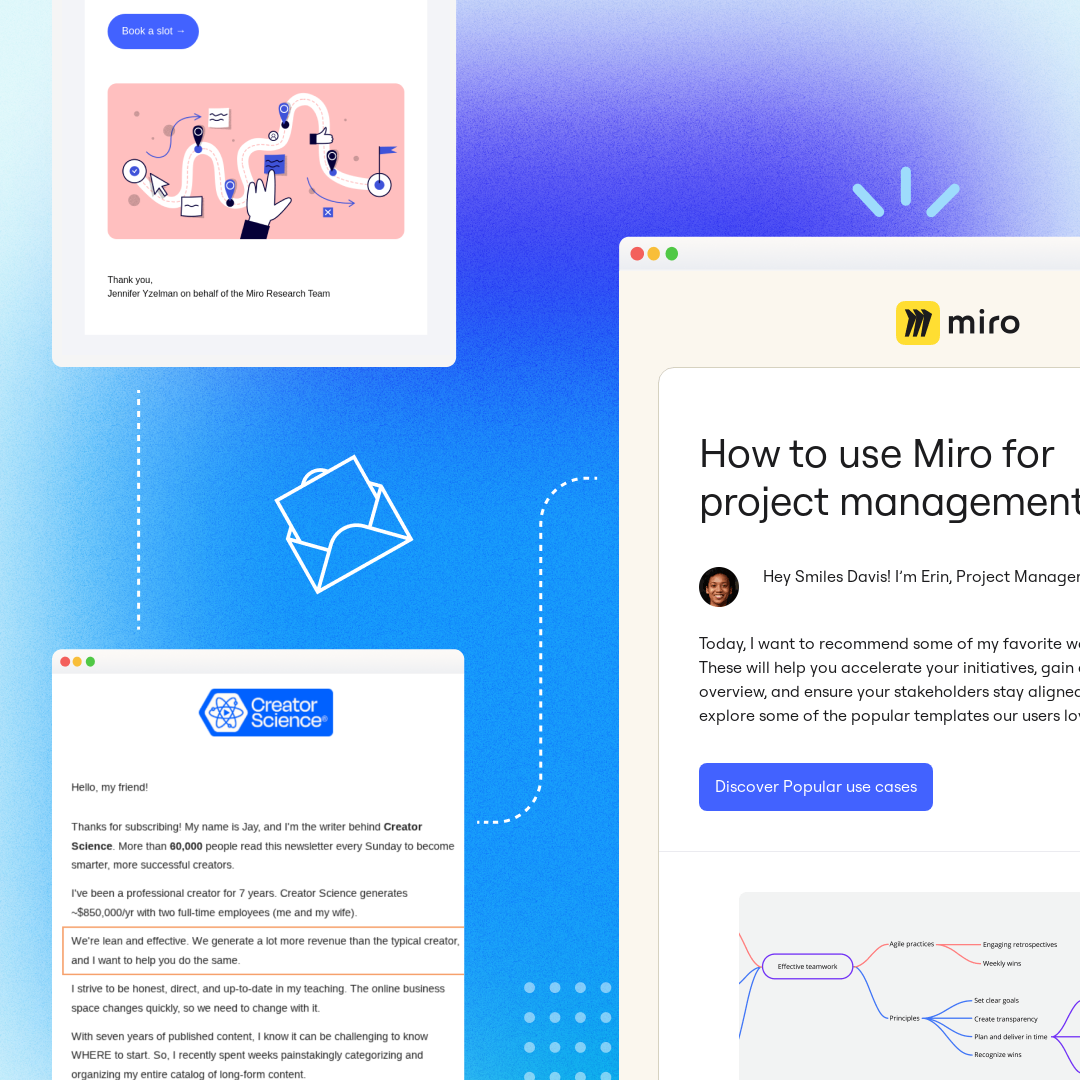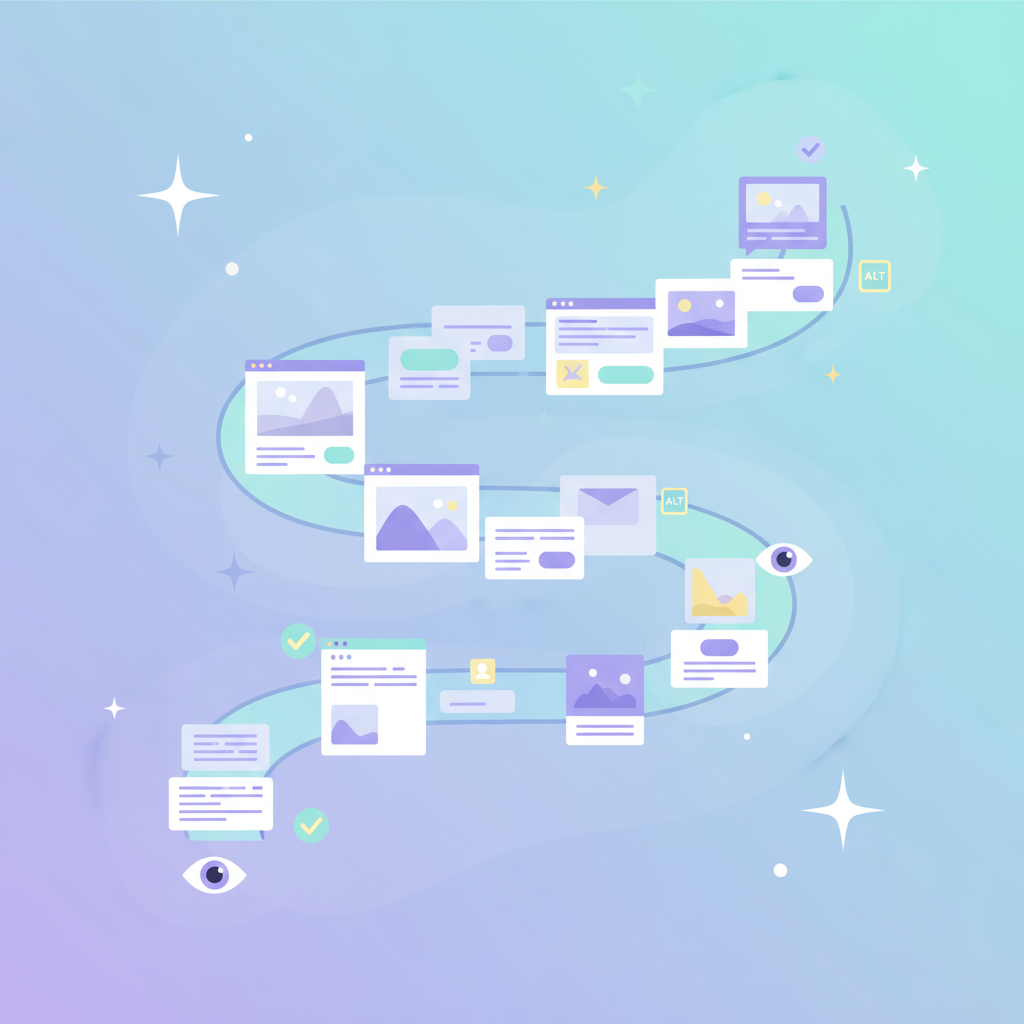
Newsletters are a powerful tool for your business: They’re a way to keep customers and leads up-to-date on what’s happening with your company, cultivating long-term relationships with people who like your brand. A good newsletter goes beyond just plain text, incorporating exciting design elements to create a pleasant reading experience for subscribers. But sending newsletters is an ongoing commitment, and it can be hard to avoid getting into a rut with your newsletter design.If you’re looking for inspiration or ideas for your next email newsletter, we have you covered. Check out these ideas that can add variety to your newsletter and capture your readers’ attention and engagement.
Newsletter Layout Ideas
Creating an effective email newsletter starts with mapping out a structure or layout for your newsletter. The layout you use can affect how customers see your newsletter, where their eyes fall, and how much they engage. Use these newsletter layout ideas to mix it up and build your newsletter strategically.
Utilize content modules
How often do you see a big block of text and blow it off, not wanting to invest so much time and mental effort into reading about one subject? Probably more often than you realize…and your newsletter readers do too. Using content modules takes away that problem and presents your content to readers in an easily digestible way.Modular content simply means separating your content into bite-sized pieces. Each module contains, say, three sentences and an image. The idea is not to get too long-winded, but if you do need to say a lot, break down what you want to say into segments for easier reading and skimming. Use design elements to signal transitions such as:
- Dividers or module borders
- Headers
- Images or design elements
- Space / extra padding
You can take an approach like Kickstarter’s Drip, which uses lines, borders, and colors to separate one piece of newsletter content from the next.

As Drip has done, aim for 3 sentences max in each section or paragraph. This lets readers see the gist of your message in seconds so you don’t lose their interest when their attention span runs out.
Create an easy-to-follow pattern
You want your readers to take in as much of your message as possible, and one way to do that is to understand and work with the natural way they read emails. That’s why a common best practice in email marketing is to use a Z-pattern layout.
Many readers start reading an email from the top left and move down and to the right as they read before their eyes return to the left side again, following a Z-like pattern. You can use that knowledge by designing your email newsletter in that same pattern, putting key takeaways in the top left, then below and to the right, then back to the left side, and so on.
To see this newsletter format idea in action, check out this example from Lion Brand Yarn:

After the initial Granny Square Day graphic, this newsletter uses a Z pattern to highlight different crochet patterns that use granny squares, aligning with readers’ natural eye movements to encourage more engagement.
Consider an image-based layout
Images have a way of catching people’s eyes. Consumer surveys show that two-thirds of people prefer emails that have more images rather than more text, and the same study found that image-focused emails have higher open rates and higher click-through rates than emails without images.
You can harness that knowledge by putting more emphasis on images rather than texts in your email newsletters. Check out this email from Oprah for example:
Subject line: Malcolm Gladwell: The dangerous consequences of prejudging strangers

While there’s enough text to communicate the message and link readers to further engagement, most of the email’s space is spent on images rather than text. This draws in consumers’ attention and encourages them to click further.
Format your newsletter as a list
A great “trick” for your email newsletter layout is to put your content in a list. Just organizing information in a numbered list is soothing on the brain, isn’t it? Suddenly, what you have to say seems more organized. Many newsletters are formatted as round-up lists or bullet point lists. For example, the WW Club starts its newsletter with a numbered list each week:

What’s also great about this email is that each module offers different content, or at least organizes the content in a different way: a photo, a numbered list, and then a center-aligned list. The variety makes for a more visually interesting newsletter—and one we want to keep reading.
Email Newsletter Design Ideas
Choosing an email newsletter layout is a strong first step for creating an engaging and interesting newsletter, but then it’s time to dig further into the design. How can you design your email in a more appealing, effective way? Use these newsletter design ideas for your next campaign.
Focus on branding
An effective email newsletter should work toward multiple goals. Not only should it entice readers to engage further with your organization but it should also contribute to building your brand awareness and brand loyalty. For that reason, be sure that every email newsletter is designed with your brand in mind. Readers who are already familiar with your brand should be able to immediately know that the newsletter is from you and readers who are seeing your brand for the first time should be able to form an immediate impression of who you are and what you’re about.
For instance, take a look at this newsletter from the Breast Cancer Research Foundation:
Subject line: What are you doing in October?

The Breast Cancer Research Foundation’s branding strategy is subtle but effective, with pops of bright pink throughout. The mysterious subject line compels readers to open up the email, and even the hyperlinks and CTA tie back into the branding strategy.
Create seasonal emails
The calendar will always hold the key to a piece of your consumers’ mindsets - in the summer, there are summer activities on their minds, and when there’s a particular holiday coming up, that holiday is in their thoughts. Designing your emails based on the season will make your newsletters more relatable to consumers because they appeal to a topic that they’re already thinking about.
Lifestyle website PureWow sent a fall-inspired email full of autumn colors and images — you can practically feel the autumn breeze just by looking at it. The newsletter layout is also well-designed, with images neatly lined up two-by-two.
Subject line: The easiest fall dinners ever

PureWow knows that their consumers are already in a fall-inspired state of mind, so they capitalize on this by showcasing fall-themed content that will naturally interest their readers.
Incorporate color into your design
Color plays a big role in your newsletter design;for almost 93 percent of people, colors are actually the number one influencing factor in a purchase! You can use techniques such as incorporating colorful images or color blocking (click hereto learn how) in your newsletter design to create an on-brand email that’s fun to read. POPSUGAR utilized the power of colorful images here to create a beautiful newsletter showcasing its latest web articles.Subject line: Are you emotionally healthy? Here are the signs that you prioritize your well-being

Keep your message simple
Simplicityin your newsletter design is a good thing; less is more. You don’t want to overwhelm your subscribers with multiple bright colors, long blocks of text, and so many images they have to scroll forever to reach the footer. And asThe Atlanticproves here, simple emails don’t have to be boring.Subject line: The Atlantic Photo - the photography of Margaret Bourke-White

The Atlantic’s newsletter is simple but eye-catching and easy to read. The image at the top is striking and the pop of red on the logo and the CTA button help this email stand out.
Include interactive content
Which is more interesting to you: if someone teaches you a concept by telling you about it or if they have you perform an activity to learn it? The more interactive content is, the more engaging and interesting it is likely to be, and that holds true in email newsletters too.
Interactive content can be defined as anything your readers click on, manipulate, or interact with, and it leads to twice the conversion rate of passive content. Including interactive content in your own newsletter design is a great way to engage your subscribers. Check out the way Rover has done this:
Subject line: Which stores welcome pets like your dog

Not only can readers click on the various links and articles throughout the newsletter but they can participate in the poll of the week too. People love to be asked for their input or opinion, so this poll is a fantastic way to engage readers.
Use Templates for Easy Newsletter Design
Reading emails from other companies is a good way to get the creative juices flowing, but now it’s time to go create your own newsletter. To save time, use Beefree’s free editable newsletter templates; these templates can help you create a beautiful newsletter that people want to read. Whether you’re a fashion brand, a charity, or a travel brand, Beefree has business newsletter templates that will work for you. Happy designing!Editor’s Note: This post was updated on September 2023 to ensure accuracy and comprehensiveness.



